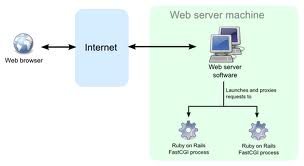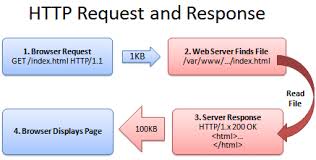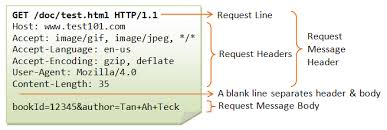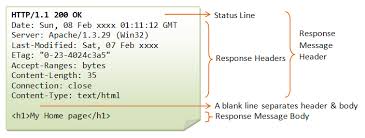Language of the Internet
- We will look at from a developers perspective. A solid understanding will allow you to understand and debug web applications.
-
Are Entities or Objects that live on a server.
-
We get , (html, json, xml, pdf,...), Representations of these resources in the body of a HTTP Response sent back to the client from the server.
-
A resource may have all or a subset of CRUD operations.
For example, a Book may be resource that can be represented in html, json, pdf, mobi, etc. It may be created, read, updated and deleted.
- A resource's representation will be determined by the Media Type which is the value in the Accept HTTP Request Header and the Content-Type in the HTTP Response Header.
For example, to get the html representation of a Book resource the HTTP Request Accept header should be set to text/html by the client.
If a server is returning the pdf representation, in the body of the HTTP Response, the Content-Type would be set to application/pdf.
- The location, or address, of the resource is specified by a URL.
- These Protocols are defined by Request For Comment (RFC) documents. No need to dig into these now.
- We are going to focus on the HTTP protocol.
* Browser. Chrome, Firefox, Safari, IE, …
* Command line utilities. curl, wget
* HTTP Ruby libraries. HTTParty, Faraday, Typhoues, ...
* Apache, Nginx, Thin, Tomcat, Pow, WEBRick …
Web Frameworks typically sit behind a Web/HTTP Server. They can run on one or more Servers, behind one or more Web Servers, receive a HTTP Request and generate a HTTP Response.
- Ruby - Rack, Sinatra, Rails, Padrino, etc.
- PHP - Zend, Laravel, etc.
- Python - Django, ...
- Java - Grails, Spring, ...
From a HTTP client,typically a browser, to a web server running on a host system.
* HTTP Request Methods
GET and POST most used.
* GET. Retrieve a resource.
* POST. Create a resource.
* PUT. Update a resource.
* DELETE, Delete a resource.
* HEAD, Retreive the headers for a resource.
* GET HTTP Request Format
[method] [URL] [version]
[headers]
* Example GET Request:
GET http://vermonster.com HTTP/1.1
Accept:text/html,application/xhtml+xml,application/xml;q=0.9,image/webp,*/*;q=0.8
Accept-Encoding:gzip,deflate,sdch
Accept-Language:en-US,en;q=0.8
Connection:keep-alive
Host:vermonster.com
User-Agent:Mozilla/5.0 (Macintosh; Intel Mac OS X 10_8_5)
AppleWebKit/537.36 (KHTML, like Gecko) Chrome/32.0.1659.2 Safari/537.36####
* Media Types
What kind of resource can we retrieve? Defined by Multipurpose Internet Mail Extensions (MIME) standards. Used in the HTTP Request Accept Header and the HTTP Response Content-Type Header.
* HTML = text/html
* GIF Image = image/gif
* PNG Image = image/gif
* MP4 Video = video/mp4
* PDF = application/pdf
* JSON = application/json
* May have a body for creating or updating a resource.
Submitting a HTML Form will send the Form contents in the body of the Request.
The body will be url encoded.
* The HTTP Request Accept header set to application/x-www-form-urlencoded
* name1=value1&name2=value2&...
See Media Types*
Reply to a HTTP client from a web server.
* HTTP Response Overview
[version] [status] [reason]
[headers]
[body] # typically HTML, json, ...
* HTTP version should be 1.1
* Status Codes, [Status Codes](http://en.wikipedia.org/wiki/List_of_HTTP_status_codes)
* 200 OK
* 301 Moved Permanently
* 302 Moved Temporarily
* 400 Bad Request
* 403 Forbidden
* 404 Not Found
* 500 Internal Server Error
* curl. Command line apps that sends requests.
* curl -i http://www.vermonster.com/
* Chrome Inspector. Developer tool built into Chrome browser.
* View -> Developer -> Developer Tools
* Select Network
* Cmd-R to send request
Break up into groups of three. Do some research, maybe using the HTTP book, and answer all of the below questions:
- What is a RFC and how does it apply to HTTP?
- What are the HTTP methods and what/when are they used?
- What are the HTTP status codes and how are they grouped?
- What is the Accept HTTP Header used for?
- What are media types and which of these are used for HTML, JSON and plain text?
- What is the Content-Type header?
- Where do the HTTP status and Headers live? In the Request or Response?
-
<scheme>://<host>:<port>/<path>?<query>#<fragment>
-
URL Scheme. Part before the ://
- http, https, ftp, ssh, ...
- http, https handled by a web server.
- ftp handled by a FTP server/daemon.
- ssh handled by a SSH server/daemon.
-
Host. Name of the computer hosting the resource
-
google.com, help.github.com, etc.
-
localhost is a special hostname that points to the computer your working on.
-
Translated to IP Address by DNS (Domain Name System)
- > nslookup news.ycombinator.com
- > dig news.ycombinator.com
-
localhost is translated to 127.0.0.1 which is the IP address of your local computer.
-
-
Port. A URL may have a port number. The port number will be after the host name but before the path.
- Default ports are ports that will be used if a port is not included in a URL.
- Port 3111. http://railsinboston:3111/end_of_the_internet.
- Port 80 is the default port for http.
- Port 443 is the default port for https.
- Port 3000 is the default port for rails applications running locally. http://localhost:3000
There are many ports on each host system. Some of them are permanently assigned to protocols.
- List of assigned port numbers.
- Default ports are ports that will be used if a port is not included in a URL.
-
Path. Points to a resource on a host system.
- For the URL:
- The Path is:
- /articles/installing-git-html-help
This typically indentifies an html page, executing code/script, image, etc behind a web server
-
Query String. Used to send parameters to the web server/application.
- Everything after the '?' is the query string
- Send the name-value pair 'q', 'brocolli' to the resource that lives at www.bing.com and has the path 'search'
- The query string may have multiple parameters in the query string. Each parameter, name-value pair, is seperated by the ampersand character,'&'.
-
URL Fragment. After the query string, seperated by the pound/hash '#' symbol. Only used by the browser to identify a section of a resource.
-
URL Encoding. Some characters are unsafe for URLs, space, pound '#', slash '/', ampersand '&', etc.
- Need to use url encoded versions of these characters.
- space is %20, ampersand is %26
- URL Encodings
Some resources, like an HTML page, may have embedded links (URLs).
The browser will load these embedded resources after as it loads the containing page.
For example, a HTML page may have links to images, videos, javascript, etc that will be also be loaded by the browser.
Rack provides a minimal interface between webservers supporting Ruby and Ruby frameworks.
See the instructor_notes.md




